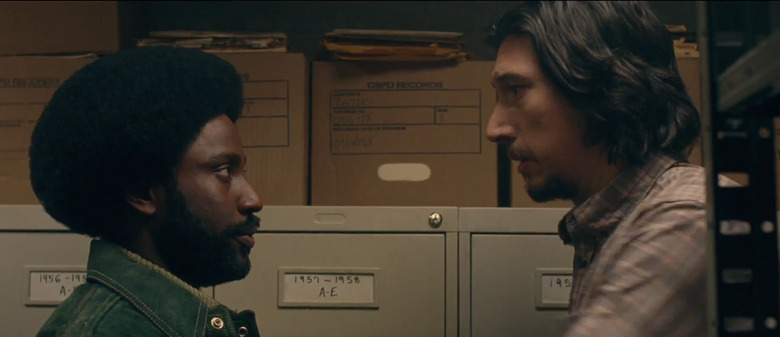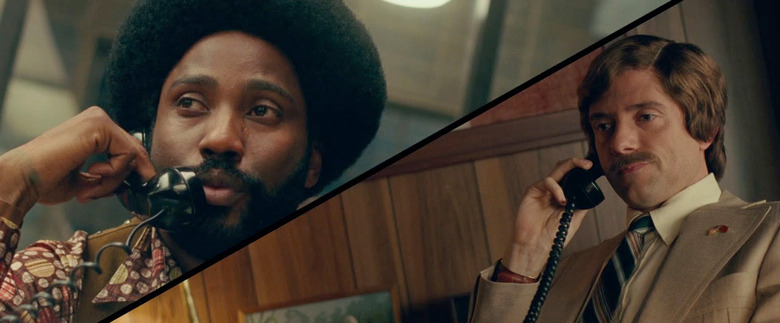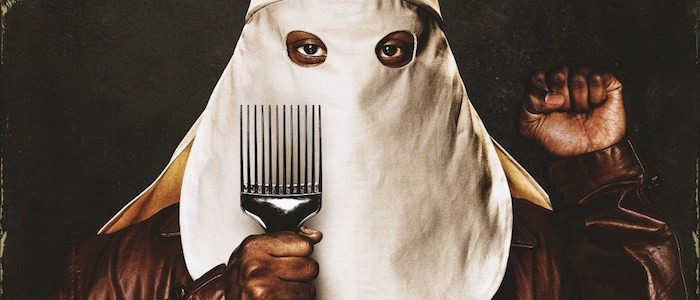Let's Talk About The Chilling, Relevant Final Scene Of 'BlacKkKlansman'
Regardless of how you feel about the film overall, the critically-acclaimed BlacKkKlansman is one of the most of-the-moment films released in the past few years. Topical to both the past and present, combining comedy, drama, and yes, downright horror, it is hard to deny that it is one of Spike Lee's greatest films in recent years. Some may even rank it among his all-time best films.The film is a crime procedural drama, tinged with blaxploitation vibes, that tells a '70s-set story that is of supreme relevance today. BlacKkKlansman chronicles Ron Stallworth (John David Washington), a black detective who infiltrates the Ku Klux Klan with the assistance of a white Jewish detective, Flip Zimmerman (Adam Driver).During its Cannes Film Festival world premiere (where it won the Grand Prix award), the film received a lengthy standing ovation, specifically due to the chilling final moments of the film, which incorporates footage from the 2017 Charlottesville counter-protest to a white supremacist rally, where Heather Heyer was killed.From easter eggs, real-life allusions, and a time-twisting blow-up, this final moment was strategically set-up throughout the film to achieve maximum power. Spoilers for BlacKkKlansman follow.
Political Ambitions
The film contains tons of tongue-in-cheek references to our present-day politics. The opening scene monologue from Dr. Kennebrew Beauregard comes off as a extreme, but not too far removed from fear-mongering tactics and dialogue spewed by the far-right in 2018. It's scary until you realize it's not that much different from things that we hear today.Then there are the several allusions toward the 2016 election and Donald Trump himself. At one moment in the film, there are scenes that point towards the transition of David Duke (played by Topher Grace in the film) from Ku Klux Klan Grand Wizard to political contender. This is a hard concept for Stallworth to understand. He tells one of his white co-workers that America "would never elect somebody like David Duke" to be president of the United States of America. Stallworth's white sergeant responds with "For a black man, you're pretty naive."Naive he was, as Duke has had multiple campaigns for political office over the years, including runs for President of the United States and a successful 1989 run for a seat in the Louisiana House of Representatives. Lee is not shy about tying Duke's seamless transition into a politician to the way Trump moved into politics.
The Representation of the 53 Percent
Throughout history, from slavery to Jim Crow to the election of Donald Trump, the role of white women and their complicity in the disenfranchisement of black people seems to be downplayed by history books and just common knowledge in general. Specifically, while we typically only think of men being in the KKK, there were many, many women members of the organization as well. A branch of the KKK specifically for women was actually started in the 1920s, and was aptly called the Women of the KKK or the WKKK.In BlacKkKlansman, the character of Connie Kendrickson is this manifestation. Not "officially" a part of the Colorado Springs sect of the hate group, she yearns to be involved and to help out in some capacity. When the group sets out to put a plan in motion to attack Colorado College's Black Student Union and their leader, Patrice (Laura Harrier), Connie is more than willing to assist in any way that she can – even doing the deed herself.Like the film itself, the character of Connie is a reflection of our past and our present. She's the representation of the women involved in the violent acts back then, as well as what many refer to now as the "53 percent," also known as the 53 percent of white women who voted for Donald Trump. At the very least, the involvement of this character in the storyline shows that racism and bigotry has no bounds when it comes to gender, though we like to only associate them with white men.
The Switch-Up
For most of the film, the KKK doesn't really doesn't get treated as a lethal threat, but portrayed more so as cartoonish villains. Yes, viewers are aware that this is the actual Ku Klux Klan, but the film lets you giggle at them in the same way that Stallworth has a laughing fit when he gets one over on David Duke and company.However, the foiled attack and subsequent Charlottesville footage, as jarring as they both are, bring the audience back to reality. There's a clear conscious decision by filmmakers to use both attacks to show that the past and the present aren't different at all – not much has changed.The planned attack in the film serves as a thrilling climax, leaving folks on the edges of their seats. The transition of Connie from cartoonish housewife to potential murderer is seamless and chilling. However, this evil plot is foiled and the film offers a sort-of happy ending for our leading man – but only for a moment. After the main story wraps up, the film concludes with footage of a white supremacist driving a car through a rally of counter-protesters in Charlottesville in 2017. The footage is gripping and unflinching, and we literally see people, real people, mowed down in the name of white supremacy.Like several other racially-tinged films of recent years, this ending drives home that while many people like to think that we are further removed from racism than we were in the '70s, we are absolutely not. There's not a difference between the planned Colorado Springs attack in the film and what happened in Charlottesville – and what happens every single day across America.By packaging this hard-hitting concept in an otherwise palatable message, Spike Lee makes it clear that we should not to take anything that is going on in our current political and social climate lightly – or for granted.



